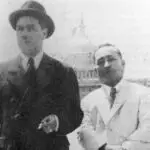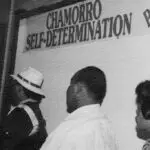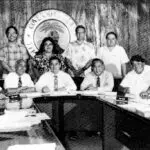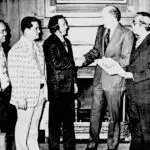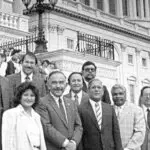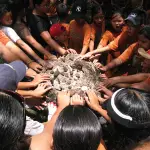CHamoru/Chamorro Self-Determination
Table of Contents
Share This
Interpretive essay: Self-determination - A promise for true democracy
To understand what the process of self-determination means for many Chamorus (CHamorus/Chamorros) on Guam, one must have some knowledge of the island’s long colonial history. After studying various events of Guam’s history, such as the defeat of the Chamoru people by the Spaniards in 1698 after the twenty-seven year Chamoru-Spanish War, and the subsequent colonization and subjugation by both the United States and Japan, it is no wonder the concepts of self-governance and sovereignty are elusive for many Chamorus today.
It seems Chamoru leaders in the past who fought against the Spaniards such as Maga’låhi Hurao, understood passionately what it meant to be self-governing and sovereign as a people. Hurao conveyed his thoughts in an eloquent speech in front of hundreds of Chamorus that, “…freedom is dearer to us than life itself….” Such a profound and bold speech led many of his people to do whatever it would take to regain their former freedom against great odds. Their defeat however, made Guam and its people a colony of Spain for the next 300 years.
After the United States acquired more territories through the Treaty of Paris which ended the Spanish-American War of 1898, these newly acquired lands were called “off-shore possessions.” The US paid Spain $20 million for both Guam and the Philippines. The earliest known legal authority giving the US sovereignty over the people of Guam can be found in the Treaty of Paris under Article IX which states that, “the civil and political rights of the native inhabitants of the islands hereby ceded to the United States shall be determined by Congress.” The “Territorial Clause” of the US Constitution which then followed the acquisition, states, “The Congress shall have Power to dispose of and make needful Rules and Regulations respecting the Territory and other property belonging to the United States” (US Constitution Article 4, Section 3).
Notwithstanding this authority, however, President William Mckinley in 1898 issued an Executive Order transferring jurisdiction and governance of the people of Guam to the Department of the Navy. Moreover, in the 1901 case of Downes v. Bidwell , which is one of several Insular Cases, the US Supreme Court established that,
- The Territorial Clause under Article IV of the US Constitution applied and gives Congress plenary powers over Guam and its people.
- The US Constitution does not apply to the Chamoru people of Guam.
- Guam is an Unincorporated Territory, which means that Guam is merely a possession and not a part of the United States.
These findings by the highest court only solidified naval rule over a civilian population. As a result, for the next fifty years, the Chamoru people became wards of the US governed by the US Navy. The naval rule of Guam was paternalistic, dictatorial and autocratic. Their mission was given primacy over civilian needs. Laws affecting the civilian population were promulgated through Executive Orders which, in today’s standards, can be construed as either racist or unconstitutional—for example, prohibiting the usage of the Chamoru language; whistling; and inter-racial marriages. Chamorus, naturally, resented the many absurd laws.
In 1902 and for the next fifty years of naval rule, the Chamorus conveyed their grievances and opposition towards the naval government to the US Congress, calling for redress for the people’s lack of civil and political rights. Congress, however, ignored the many petitions filed by the Chamoru people.
In 1945 after the defeat of Japan and Germany in World War II, in order to promote peace and cooperation amongst peoples throughout the world, the US, along with fifty-one other independent nations, gathered and formed the United Nations. The UN Charter was adopted, signed and ratified by each respective member state. The Charter enumerated the purposes and mission of the UN, which includes resolving international disputes and the decolonization of former colonies.
In December 1946, pursuant to Article 73 of Chapter XI of the UN Charter, the US—along with others nations that possessed colonies such as France, Portugal, New Zealand, United Kingdom and Spain—placed all their possessions in a list of “Non-Self-Governing Territories” (UNGA Resolution 66-1). The goal was the eventual decolonization of all territories with each attaining a full measure of self-government. By 1960, more than two-thirds of former colonies on the non-self-governing list had exercised their right to self-determination. More than one hundred states in the United Nations today were former off-shore possessions or colonies of the above-mentioned countries. These new states are now independent nations and are voting members in the UN. They are treated as equals to other member states within the UN General Assembly.
That same year, the UN stated that the pace of decolonization for the remaining territories was too slow. The inaction by administering powers to proceed in the decolonization process for these territories resulted in the passage of two landmark resolutions by the UN General Assembly: UN Resolution 1514 (XV), or the Declaration on Decolonization, and UN Resolution 1541, which delineated the ways in which a territory could achieve self-determination.
Summarized here, UN Resolution 1514 (XV) states:
- The subjection of peoples to alien subjection, domination and exploitation constitutes a denial of fundamental human rights, is contrary to the Charter of the United Nations, and is an impediment to the promotion of world peace and cooperation.
- All peoples have the right to self-determination; by virtue of that right they freely determine their political status and freely pursue their economic, social and cultural development.
- Inadequacy of political, economic, social or educational preparedness should never serve as a pretext for delaying independence.
- All armed action or repressive measures of all kinds directed against dependent peoples shall cease in order to enable them to exercise peacefully and freely their right to complete independence, and the integrity of their national territory shall be respected.
- Immediate steps shall be taken, in Trust and Non-Self-Governing Territories or all other territories which have not yet attained independence, to transfer all powers to the people of those territories, without any conditions or reservations, in accordance with their freely expressed will and desire, without any distinction as to race, creed of colour, in order to enable them to enjoy complete independence and freedom.
- Any attempt aimed at the partial or total disruption of the national unity and the territorial integrity of a country is incompatible with the purpose and principles of the Charter of the United Nations.
- All States shall observe faithfully the provision of the Charter of the United Nations, the Universal Declaration of Human Rights and the present Declaration on the basis of equality, non-interference in the internal affairs of all States, and respect for the Sovereign rights of all peoples and their territorial integrity.
UN Resolution 1514 radically changed the process of self-determination and made it a “right” rather than a ”principle” for peoples of non-self-governing territories. Prior to 1960 administering powers who were determined to hold onto their former territories or possessions would use the latter, arguing that self-determination was just a matter of principle not a right. The passage of Resolution 1514 changed all that and gave new hope for those still under the hegemony of colonialism.
By 1961, the United Nations created a more formal process in expediting decolonization. A Special Committee on Decolonization, also known as the Committee of 24, was established. This committee is comprised of representatives of former colonized peoples. Seminars and meetings by this committee are held in the Caribbean and Pacific, alternating each year. Their mission is to gather information as to the political development of the remaining non-self-governing territories. Such reports are then submitted to the Fourth Committee which prepares the reports for the General Assembly in their annual December meeting. The General Assembly, in turn, votes on the Resolution regarding the status of the remaining non-self-governing territories.
Each year since 1946 the status of Guam’s political development is mentioned in every UN Resolution. Guam is one of sixteen remaining territories that have yet to exercise their right to self-determination. The UN General Assembly, through the UN Resolutions, continues to remind the US of its treaty obligations under the Charter regarding the decolonization of its “possessions.”
Summarized here, UN Resolution 1541 (XV) states:
[Resolution] 1541 gives three ways that a Non-Self-Governing Territory can attain a full measure of self-government as prescribed by the Charter.
(a) Free association with an independent state as a result of a free and voluntary choice by the people of the Territory expressed through an informed and democratic process;
(b) Integration with an independent state on the basis of complete equality between the peoples of the Non-Self-Governing Territory and those of the independent state;
(c) IndependenceWhatever the political status chosen by the people of a Non-Self-Governing Territory, this choice must be the result of the freely expressed wishes of these peoples.
Colonialism is the rule or control of one power over a group of people. Decolonization is the movement of the colonized people from being governed by an external power to governing themselves or to be self-governing. Self-determination is the expression and desire of the colonized people to determine their political destiny. A Non-Self-Governing Territory is defined in the UN Charter as a territory “whose people have not yet attained a full measure of self-government.”
The exercise of self-determination: Internal or external approach
There are two ways which in the colonized people and their administering power approach the issue of self-determination. The first approach is “internal” in which occupying powers or administering powers would unilaterally prescribe a political arrangement with the colonized people internally without United Nations intervention or oversight. The occupying power regard the colonized as a domestic people or minority population.
The US, for example, in dealing with Native American Indians created a “nation within a nation” political relationship. Native Americans can exercise some political autonomy within the boundaries of an existing state in the US. This type of political arrangement resulted from treaties signed between the US federal government and the remaining American Indian tribes shortly after the systematic genocide campaigns of the “Indian Wars” against Native Americans in the 1800s. In the nation within a nation structure, the US government dictates the parameters of its political relationship with native tribes. The US government set aside lands for native reservations and all tribes were permitted a very limited form of self-government. Congress, however, pursuant to the US Constitution under the Territorial Clause retains plenary powers over all reservations.
For Guam, the US Supreme Court in 1901 established the island as an “unincorporated territory.” That is, Guam is a possession and not a part of the US. The Court also resolved that it is the US Congress that determines the standard of governance and not the US Constitution. This ruling established the difference between how US laws apply to lands that were acquired by the United States in 1898 and those acquired earlier. Although the Organic Act of 1950 passed by Congress provided a limited form of self-government, it is still considered both “internal” and “unilateral”, since it remains a one-sided colonial form of governance.
The second approach of self-determination is called “external,” and emerged shortly after the creation of the United Nations in 1945. In December 1946 the US placed Guam, Hawai’i, Puerto Rico, Samoa and the US Virgin Islands in the list of “Non-Self-Governing Territories” pending decolonization under UNGA Resolution 66-1. Article 73 of Chapter XI of the UN Charter states that, “territories listed that have yet to achieve a full measure of self-government obligates the administering power that the interests of the inhabitant of these territories are paramount” and that by signing the Charter, administering powers accepted as a “sacred trust” the “obligation to promote to the utmost the well-being of the territories under their administration.”
Moreover, the General Assembly Resolution 1514 (XV) of 14 December 1960 declares that: “All peoples have the right of self-determination; by virtue of that right they freely determine their political status and freely pursue their economic, social and cultural development.” In this type of approach toward self-determination a tripartite commitment exists between the United Nations, the administering power and the people of the territories or colonized peoples. The colonized people are given the three types of political status options under UN resolution 1541 which would comply with what the UN deems is a full measure of self-government—independence (free from external rule); free-association (with an independent state); and integration (or statehood).
Since 1946 the US has remained aloof regarding the question of political status for the Chamoru people of Guam, treating it as an internal or domestic issue. Guam’s strategic location as America’s westernmost Pacific outpost, as well as Cold War politics, have made the US historically disinterested in decolonizing Guam pursuant to UN treaties.
The Chamoru people have persistently tried to assert their rights to self-determination in various ways, and history offers several examples. The 1949 walkout by the Guam Congress, for instance, was motivated by desires for civil and political rights for the Chamoru people. The actions of the Guam Congress pressured the US to provide some kind of relief for Guam from under military rule, resulting in the Organic Act of 1950. While the Organic Act gave the Chamoru people of Guam limited self-government and granted congressional US citizenship, Guam leaders pushed the federal government for subsequent, though piecemeal, amendments and other legislation, such as the Elective Governor Act of 1968, the election of Guam’s Delegate to Washington in 1972, and the establishment of the Guam Supreme Court in 1996. The Organic Act with all its modifications, though, still fails to meet UN standards of a “full measure of self-government.”
The Commonwealth Act in the 1980s, which was to serve as an interim status for Guam, was also an internal approach to improving the island’s political relationship with the US. However, after nearly two decades of negotiations with federal officials the proposed Commonwealth Act died in Congress. The inaction by the US government was an indirect “no” to the wishes and aspirations for an interim status for the people of Guam.
In January 1997 Guam’s political leaders took a different approach in the quest to resolving its political relationship with the United States. The enactment of Public Law 23-147 created the Commission on Decolonization and the Chamorro Registry to begin registering eligible voters for a future political status plebiscite. This law mirrors what was prescribed by the UN and represents an external approach to exercising self-determination. Here, a tripartite effort exists between the administering power, the colonized people and the United Nations. The administering power, or the US government, has been tasked with preparing the process of decolonization through funding and educating the people of the territory of the three political status options available for them.
The colonized people who should participate in this exercise are those who were made citizens of the United States and their descendants by virtue of the passage of the Organic Act in 1950. The third partner is the UN which has been tasked to observe and monitor the vote along with ascertaining whether a full measure of self-government is achieved through the freely expressed wishes of the people of the territory.
When the US participated in the signing and ratification of the UN Charter in the 1940s, the US accepted as “a sacred trust” their treaty obligation regarding decolonization of non-self-governing territories. By placing Guam—through the US’s own volition—on the UN list of non-self-governing territories, it participated in an agreement that should have led eventually to the decolonization of Guam and self-determination for the people of the territory. The Guam Legislature also has chosen the same route consistent with the UN decolonization process with the passage of Public Law 23-147.
Guam today has two legal statuses. As an unincorporated territory Guam is a possession of the US, but not a part of the US. Secondly, Guam is a non-self-governing territory and, as a possession, was promised a full measure of self-government pursuant to US treaties and agreement as a member of the UN. Many people on Guam see the Organic Act as an antiquated document that leaves them feeling like they are second class citizens because they are denied the right to vote for their president, nor do they have a voting delegate in Congress.
Guam today is undergoing rapid demographic, economic, social, environmental and technological transformation. The island’s proximity to the robust economies of Asia has contributed to some of these changes. Guam, however, cannot continue to have people in the federal government 7,000 miles away in Washington, DC make crucial decisions that affect Guam daily. Instead, a full measure of self-government would give Guam the freedom to exercise their control over issues that are part of the daily lives of its people.
Guam is the only island in Micronesia whose people have yet to exercise their right to self-determination. The island remains on the list of non-self-governing territories around the world. For self-determination to occur, the people of Guam must work in solidarity. There must be bipartisan support and effort between the three branches of government to call for the exercise of self-determination. For the administering power (the US), it is just a matter of complying with its treaty obligations and fulfilling their promises—then it will be possible for self-determination to become a reality.
Video: Let Freedom Ring
The film Let Freedom Ring, The Chamorro Search for Sovereignty by the Cabazon Band Of Mission Indians in 1997. View in Vimeo Let Freedom Ring, Clips 1-8.

